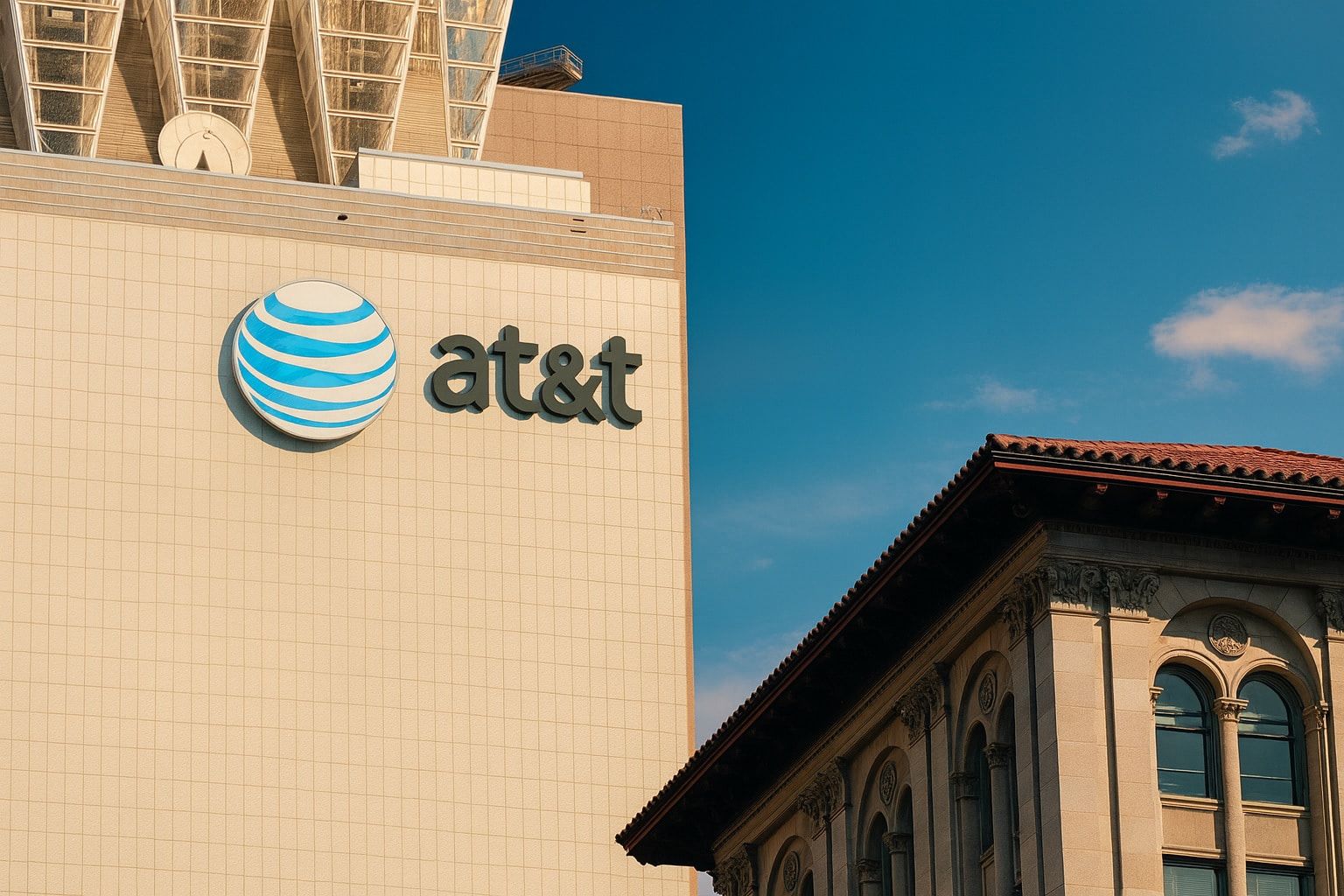- Stock Price & Performance: AT&T Inc. (NYSE: T) stock is trading in the mid-$25 range after recent earnings, roughly flat for the month of October [1]. Shares are up about 20% year-over-year, though they’ve lagged the broader market’s rally in recent weeks [2]. Over the past 12 months, AT&T’s stock has ranged from a low near $21 to a high just under $30 [3]. The stock’s low volatility (beta ~0.4) reflects its defensive, dividend-oriented nature [4]. At the current price, AT&T offers a hefty dividend yield of approximately 4.2%, with a quarterly payout of $0.2775 per share – underscoring its appeal for income investors [5] [6].
- Q3 Earnings – Big Subscriber Beat, Slight Revenue Miss: AT&T’s third-quarter 2025 results, reported on Oct. 22, showcased 405,000 net postpaid wireless phone subscribers added – far above the ~334,000 analysts expected [7] [8]. The company also added 288,000 fiber internet customers and 270,000 fixed-wireless (“Internet Air”) subscribers, marking its highest total broadband adds in over 8 years [9]. This robust customer growth was driven by aggressive iPhone 17 promotions and bundled wireless + internet deals. Revenue came in at $30.7 billion (up 1.6% YoY), just shy of the ~$30.85B consensus due to slightly softer device sales [10] [11]. Adjusted earnings were $0.54 per share, right in line with forecasts [12]. AT&T reaffirmed its full-year 2025 outlook (adjusted EPS of ~$1.97–$2.07 and low-single-digit revenue growth) and noted results are tracking toward the high end of guidance [13] [14].
- Market Reaction: The strong subscriber news initially sent AT&T’s stock up about 4% in pre-market trading [15]. However, shares pulled back ~2% by the Oct. 22 close, ending around $25.52 [16]. Investors appeared to weigh the “mixed” quarter – blockbuster customer gains versus the slight revenue miss and higher costs from those promotions [17] [18]. Some analysts characterized the results as “so-so”, noting that intense competition and heavy iPhone subsidies, while boosting sign-ups, may pressure profit margins [19] [20]. Notably, AT&T’s postpaid phone churn remained low (~0.92%) despite rivals’ promotional offers [21], a positive sign for customer retention.
- 5G & Fiber Expansion Moves: 2025 has seen AT&T double down on its core connectivity business with major investments in wireless spectrum and fiber-optic broadband. In late August, AT&T announced a $23 billion deal to acquire valuable 5G spectrum licenses from EchoStar, adding a huge 50 MHz of mid-band and low-band spectrum nationwide to bolster its network [22]. And in May, AT&T agreed to buy Lumen Technologies’ consumer fiber unit for $5.75 billion, which will bring roughly 1 million new fiber subscribers and expand AT&T’s fiber footprint into cities like Denver, Phoenix, and Seattle [23]. These strategic bets aim to future-proof AT&T’s coverage and capacity. CEO John Stankey said the EchoStar spectrum purchase “bolsters and expands our spectrum portfolio” and will enhance customers’ 5G and home internet experience across more markets [24]. The Lumen fiber acquisition (expected to close by early 2026) adds 5 million potential new fiber locations to AT&T’s network [25].
- Streamlining and Financial Focus: AT&T has been shedding non-core businesses to focus on telecom and strengthen its finances. In July, the company sold its remaining stake in DirecTV, effectively exiting the legacy pay-TV business [26]. Management also announced plans for $20 billion in share buybacks through 2027 (with ~$1.5B already repurchased in Q3) as a vote of confidence in AT&T’s cash flows [27] [28]. The company aims to roughly double its fiber internet reach to 60+ million locations by 2030 (through build-out and acquisitions) [29]. AT&T’s debt remains high (net debt around 3× EBITDA after the spectrum purchase), but the firm vows to cut leverage to ~2.5× in the next 3 years [30]. Executives cite an expected $6.5–8 billion in cumulative tax benefits through 2027 that will help with debt reduction [31]. Despite the debt load, AT&T’s current interest coverage and strong free cash flow ( ~$16B target for 2025) support its dividend and buyback plans [32].
- Analyst Sentiment & Outlook: Wall Street’s view on “T” is cautiously optimistic. The consensus rating is a Moderate Buy, with around 17 out of 23 analysts rating it Buy/Overweight and the rest on Hold [33] [34]. The average 12-month price target sits around $30–31 – roughly 15% above current levels [35]. Post-earnings, several analysts reaffirmed bullish stances: Goldman Sachs maintained a “Buy”, recently raising its target to about $32–$33 as AT&T’s investments in 5G/fiber are seen as smart long-term moves [36] [37]. JPMorgan, Morgan Stanley, and others also have targets in the low $30s, reflecting expectations of modest upside as execution continues [38]. On the cautious side, Barclays downgraded the stock on Oct. 1 to Equal Weight (Hold), arguing AT&T’s recent rebound already “largely reflects its operational gains” and flagging the twin challenges of intense wireless competition and high debt levels [39] [40]. Overall, analysts favor AT&T’s 4%+ dividend yield and cheap valuation (about 13× forward earnings, well below the telecom industry’s ~21× average) [41]. But they also note that the company’s slow growth profile and ongoing price wars in wireless could limit near-term stock appreciation [42].
AT&T Stock Price & Recent Performance
AT&T’s stock has been range-bound in the mid-$20s for most of October, even as the broader market climbed to new highs [43]. Leading up to earnings, the shares were essentially flat month-to-date, trading around the $26 level. Year-to-date in 2025, AT&T has posted a modest gain of roughly 15–20%, which lags the tech-heavy Nasdaq’s performance in the same period [44]. However, zooming out, the stock is up about 20% from a year ago – a rebound that has actually outpaced rival Verizon over the last 12 months [45] [46].
Even at its summer peak near $29.79 (a 52-week high) and recent low around $21 [47], AT&T’s stock has not exhibited extreme volatility. Its low beta (~0.4) means the stock tends to move less than half as much as the overall market [48], befitting a telecom utility-like equity. This stability is partly due to the company’s reliable dividend. AT&T pays an annual dividend of $1.11 per share (after a 2022 payout reset), which at the current price yields about 4.2%. That yield is attractive relative to the market, though not the highest in the sector – Verizon’s recent selloff has pushed its yield above 7% [49]. AT&T just declared its next quarterly dividend of $0.2775 (payable Nov. 3), signaling its commitment to steady shareholder returns [50].
In the days around the Q3 report, AT&T’s stock saw unusual swings. Ahead of earnings, investors were in “wait-and-see” mode, with the stock in a holding pattern [51]. When results hit on Oct. 22, strong subscriber numbers initially gave the stock an upward jolt – it jumped roughly 4% in pre-market trading on excitement about the customer growth beat [52]. But once the regular session opened, sentiment turned more cautious. AT&T’s shares closed down about 2% on Oct. 22 at $25.52 [53], despite the solid operational news. This retreat came as investors digested some less rosy aspects: a slight revenue miss and concern that the cost of aggressive promotions (which drove the subscriber surge) could pinch margins [54] [55]. Notably, the whole telecom sector wobbled that day – peer Verizon’s stock also fell ~2% – amid broader worries about pricing wars and higher customer acquisition costs [56]. In short, AT&T’s stock is basically back where it was a week ago, reflecting a balance of optimism about subscriber momentum against lingering concerns about revenue quality and expenses.
Q3 2025 Earnings Highlights – “Growth vs. Margins” Story
AT&T’s third-quarter 2025 earnings report (released Oct. 22) underscored the company’s strength in attracting customers, even as some financial metrics came in merely average. Total revenue was $30.7 billion, a 1.6% rise year-on-year, which slightly undershot Wall Street’s ~$30.85 billion forecast [57] [58]. The shortfall was mainly due to a dip in equipment sales – likely a timing issue as many customers held out for new iPhones and promotions. Indeed, equipment revenue still grew ~6% (to $4.8B) but missed estimates, as AT&T sold more pricey phones but at higher promotional cost [59] [60]. Meanwhile, service revenues in the core wireless segment rose about 2.3% to $16.9B, buoyed by the influx of subscribers [61]. On the profitability side, adjusted EPS was $0.54, matching consensus (though down a few cents from a year ago, as expected) [62]. On a GAAP basis, EPS came in at $1.29, but that figure was inflated by a one-time $5.5 billion gain from the DirecTV stake sale [63]. Excluding that accounting item, AT&T’s earnings were essentially flat – indicating the company is holding margins steady for now.
The headline win was subscriber growth. AT&T delivered 405,000 net postpaid wireless phone additions, decisively topping the ~334,000 net adds that analysts had forecast [64] [65]. This marked AT&T’s best wireless user growth of the year. Executives credited a combination of tactics: hefty promotions around Apple’s iPhone 17 launch, plus discounts for customers who bundle wireless and fiber broadband services [66] [67]. Those efforts clearly paid off – AT&T revealed that over 41% of its fiber internet customers now also subscribe to an AT&T mobile plan [68] [69]. This cross-selling both boosts subscriber numbers and reduces churn by making customers more likely to stick with AT&T for all services. AT&T’s postpaid phone churn was just ~0.92% in Q3 [70], a low level indicating strong customer loyalty (for context, churn below 1% is considered excellent in the industry).
Beyond wireless, AT&T saw broadband gains that were record-setting. The company added 288,000 fiber internet subscribers in Q3, continuing its rapid fiber rollout success [71]. It also added 270,000 fixed wireless access customers to its new “Internet Air” service, which uses 5G signals to deliver home internet [72]. Combined, those 558,000 total broadband net adds were the highest for AT&T in more than 8 years [73] – a statistic CEO John Stankey highlighted as evidence that AT&T’s investments in connectivity are bearing fruit. Notably, AT&T’s consumer fiber revenue jumped ~16.8% year-on-year in the quarter [74], reflecting both the larger customer base and users upgrading to faster plans.
There were, however, weak spots in the quarter. AT&T’s business wireline division (providing legacy landline and older data services to corporate/government clients) saw revenue drop about 7.8% from a year ago [75] [76]. This ongoing decline in traditional telecom services is a known drag on AT&T’s overall growth, as older technologies phase out. Meanwhile, the big promotional push had side effects: operating costs in the mobility (wireless) segment rose ~3.8% year-on-year, driven by higher device subsidies and marketing expenses tied to the iPhone promotions [77] [78]. In other words, AT&T paid up in Q3 to win those new customers. The question is whether the lifetime value of these subscribers will justify the upfront hit to margins. Thus far, AT&T seems comfortable with the trade-off – the company maintained its full-year guidance and expressed confidence that it can hit its targets while absorbing the promo costs [79]. Management noted that free cash flow is on track (AT&T still expects about $16 billion FCF for 2025 [80]), which covers the roughly $8 billion in annual dividend payouts with room to spare.
Investor reaction to the Q3 report has been mixed. On one hand, the blowout subscriber gains suggest AT&T is effectively competing in a saturated market, stealing share or boosting retention when peers are struggling (Verizon, for instance, has been losing phone subscribers and recently changed CEOs amid that pressure [81]). AT&T also affirmed that it foresees hitting the upper end of its 2025 earnings range, implying a strong Q4 finish [82]. These positives led some analysts to call the quarter a sign that AT&T’s strategy is on the right track [83]. On the other hand, skeptics zeroed in on margins and revenue quality. The slight miss on revenue (AT&T delivered $30.7B vs. $30.85B expected) gave the quarter a “not perfect” label [84]. More importantly, industry observers like MoffettNathanson warned that the coming holiday quarter could bring a “stiff headwind”: as iPhone upgrade rates normalize, carriers may have to spend even more on subsidies and will face higher churn as customers switch providers for deals [85]. In fact, AT&T itself acknowledged that Q4 typically sees seasonal upticks in switching and upgrade activity, which can pressure profits [86]. The market’s takeaway seems to be that AT&T delivered a good-but-not-great quarter – strong on user growth, soft on revenue beat, and with an expensive cost to acquire those users. That dynamic left the stock roughly where it started, as investors weigh short-term margin pressures against long-term subscriber value [87].
5G Spectrum Gambit and Fiber Expansion Strategy
Under CEO John Stankey, AT&T in 2025 has pursued an aggressive strategy of investing in network infrastructure – essentially betting that heavy spending now on 5G wireless and fiber-optic broadband will secure future growth and competitive advantages. The most eye-catching move was AT&T’s late-August agreement to purchase a vast trove of wireless spectrum licenses from EchoStar for $23 billion [88] [89]. This single deal gives AT&T about 50 MHz of additional spectrum nationwide (roughly 30 MHz in mid-band frequencies around 3.45 GHz and 20 MHz in low-band 600 MHz) [90]. Mid-band spectrum is highly valuable for 5G deployments because it offers an ideal balance of wide coverage and high data capacity. By acquiring these airwaves (instead of waiting for a government auction), AT&T aims to boost its 5G network’s capacity and coverage in one swoop.
However, AT&T paid a premium price – analysts estimate the $23B price tag is roughly $6–7B more than what that spectrum might have fetched at auction [91]. Stankey has been candid that the cost was steep, but he’s argued it was a necessary move to keep AT&T competitive in the 5G era. “This acquisition bolsters and expands our spectrum portfolio while enhancing customers’ 5G wireless and home internet experience in even more markets,” the CEO said in a statement [92]. In other words, AT&T is playing the long game, fortifying its network to deliver ultra-fast 5G and fixed-wireless services to millions of users in the years ahead. Rival T-Mobile currently enjoys a lead in mid-band 5G coverage (thanks to spectrum from its Sprint merger), and Verizon has been investing heavily in its own C-band spectrum. AT&T’s EchoStar purchase is meant to level the playing field and ensure that “Big Blue” doesn’t fall behind in the race for 5G dominance.
On the fiber broadband side, AT&T has similarly been expanding through both organic build-outs and acquisitions. Earlier in 2025, AT&T struck a deal to acquire Lumen Technologies’ consumer fiber business for $5.75 billion [93]. Lumen (formerly CenturyLink) is transferring about 1 million fiber subscribers to AT&T and over 5 million fiber-ready addresses across 20 states, significantly boosting AT&T’s footprint in regions like the U.S. Midwest and West [94] [95]. Once that deal closes (expected by early 2026), AT&T will immediately gain a huge pool of new potential customers to upsell on bundles and new services. Importantly, fiber is a high-margin, future-proof technology for internet access – it offers symmetric multi-gig speeds and is crucial for backhauling 5G wireless data. AT&T’s strategy is to blanket its territories with fiber to both homes and cell towers, creating a tightly integrated wireless and wired network. The company is targeting over 30 million fiber locations passed by 2025 (up from ~24 million now), on its way to over 60 million by 2030 with the help of acquisitions and joint ventures [96].
The heavy investments in spectrum and fiber do raise concerns about capital spending and debt, which we address in the next section. But AT&T’s leadership believes these moves are critical. By focusing on connectivity (and moving away from distractions like media content), AT&T wants to secure its role as a top-tier provider of the pipelines that today’s digital economy runs on. These bets are already starting to yield strategic benefits: for example, AT&T’s new fixed-wireless “Internet Air” service, which added 270k customers in Q3, is only possible at scale because of its expanded 5G capacity [97]. Likewise, AT&T’s robust fiber growth (288k adds in Q3) is driving broadband subscriber records and revenue growth [98]. Each fiber customer is a candidate for wireless service (and vice versa), reinforcing the “convergence” strategy of bundling mobile and home internet.
From a competitive standpoint, these network upgrades aim to protect AT&T’s turf. Verizon and T-Mobile aren’t standing still – T-Mobile has been aggressively marketing its own 5G Home Internet (fixed wireless) and just brought in a new CEO to continue its Un-carrier tactics [99], while Verizon is partnering with satellite providers to augment coverage [100]. By scooping up spectrum and fiber assets, AT&T is making sure it can match or beat rivals on network quality. It’s worth noting that AT&T’s approach carries substantial upfront costs (e.g. that $23B could strain the balance sheet in the short term), so success will hinge on executing efficiently – getting those fibers lit and spectrum deployed to generate returns sooner rather than later.
Financial Fortitude, Debt & Dividends
AT&T’s pivot back to its telecom roots has been accompanied by efforts to streamline operations and shore up its financial position. One major move was completing its exit from the TV/entertainment business. In July, AT&T sold its remaining DirecTV stake, finalizing a retreat from the satellite TV venture it once spent $49B to acquire [101]. This follows the 2022 spin-off of WarnerMedia (HBO, CNN, etc.) into Warner Bros. Discovery. These divestitures have allowed AT&T to focus squarely on wireless and broadband, and also brought in cash to reduce debt. Similarly, AT&T has offloaded other non-core assets (such as Xandr, its ad-tech unit) in recent years. The message is clear: AT&T doesn’t want distractions – it is prioritizing stable, utility-like telecom services over the glitz of media.
In terms of debt, AT&T remains one of Corporate America’s most indebted companies, a legacy of past mergers and spectrum purchases. At the end of Q3, AT&T’s total debt was in the ballpark of $130 billion (net debt about 3.0× EBITDA) [102]. The EchoStar spectrum deal, once closed, will add to that debt load. Managing this leverage is a top priority for management. AT&T has set a goal to cut its net debt-to-EBITDA ratio to ~2.5× by 2025–2026 [103]. To reach that, the company is directing surplus cash flow to pay down borrowings. The anticipated $6–8 billion in tax benefits through 2027 (stemming from loss carryforwards and credits) will also help by boosting post-tax cash flows [104]. Encouragingly, AT&T’s operating cash flow has been healthy – over $10B in Q3 alone [105] – and free cash flow (after capital expenditures) is on pace for ~$16B this year [106]. With about $2B per quarter in dividends, AT&T is covering its dividend roughly 2× with free cash flow, leaving room for debt reduction and modest buybacks.
Speaking of shareholder returns, AT&T’s dividend appears stable after the cut in 2022. The current quarterly rate of $0.2775/share has been maintained throughout 2023–2025, and management has given no indication of further changes. That yield (~4%) is quite appealing in a low-growth stock, and is a key reason many investors hold AT&T. The company’s payout ratio is reasonable (under 50% of free cash flow [107]), so the dividend looks well-supported. Additionally, AT&T surprised the market with plans for stock buybacks earlier this year: the board authorized up to $20 billion in share repurchases through 2027 [108]. This is notable because AT&T had halted buybacks during its debt-heavy acquisition years. In Q3, AT&T bought back about $1.5 billion worth of stock [109]. While that’s a drop in the bucket relative to its ~$180B market cap, it signals that management sees value in the shares at current prices. The buybacks also help offset dilution and are intended to return excess cash to shareholders. However, some analysts would prefer AT&T prioritize debt paydown over buybacks given the still-elevated leverage.
AT&T’s credit profile remains solidly investment-grade, and with interest rates possibly peaking, its interest expenses should be manageable. In fact, the broader interest rate outlook could become a tailwind: the Federal Reserve is widely expected to begin cutting rates in late 2025 if inflation continues to cool [110]. Lower rates would reduce AT&T’s future refinancing costs and also make its dividend stock more attractive relative to bonds. This dynamic could draw income-oriented investors back into high-yield telecom stocks like AT&T if bond yields decline [111]. For now, AT&T’s debt strategy is steady as she goes – use operating cash to fund network expansion, pay the dividend, and gradually chip away at debt. The company ended Q3 with about $3.9B of cash on hand and has been refinancing near-term maturities to avoid liquidity crunches. Barring any huge new acquisitions, AT&T’s debt is on a downward glide path, which bodes well for the long-term stability of its dividend and equity value.
Wall Street Commentary and Stock Forecast
Despite its stumbles in recent years, AT&T has been garnering a bit more optimism on Wall Street as it refocuses on core telecom operations. The current analyst consensus on the stock is roughly “Buy” with some reservations – effectively a Moderate Buy consensus rating [112]. Out of the major brokerages covering AT&T, most see the stock as undervalued at mid-$20s and capable of some upside, though few expect explosive growth.
Price targets cluster around the $30 mark. For instance, Goldman Sachs just reiterated a Buy and bumped its target up to $33 (from $32) after the Q3 results, citing confidence in AT&T’s wireless momentum and saying the massive spectrum investment is a “smart long-term move” [113] [114]. J.P. Morgan and Morgan Stanley are both Overweight with $31–$32 targets, and Deutsche Bank and Scotiabank have ~$30 targets, all essentially arguing that AT&T’s stable cash flows and yield merit a higher share price in the low $30s [115]. The bullish thesis is that as AT&T executes – growing its 5G subscriber base, expanding fiber, and reducing debt – the market will reward it with a multiple more in line with historical levels (perhaps 10–12× EBITDA or ~15× earnings, versus ~13× forward now). If the stock were to trade at a 15× P/E on 2025 earnings, that would indeed be around $30+ per share.
On the flip side, some analysts urge caution. In early October, Barclays cut its rating to Equal Weight (essentially Hold) and pointed out that AT&T’s valuation gap to peers had mostly closed after its 2023–2025 rebound [116]. Barclays isn’t bearish on AT&T’s execution per se, but they worry that competitive pressures – e.g. T-Mobile’s aggressive promotions and cable companies offering mobile plans – could cap AT&T’s growth and make it hard for the stock to outperform. They also note AT&T’s debt leaves less room for error if the economy turns or if wireless pricing becomes more cutthroat. HSBC similarly moved to Hold over the summer, and a few others remain on the sidelines. Even bullish analysts concede that AT&T is a “show me” story: the company must prove that it can grow revenue and EBITDA consistently in coming years, not just add subscribers by sacrificing margins [117].
The market outlook for AT&T’s stock in the near term is thus one of cautious optimism. Many observers expect the stock to remain in its recent trading range (mid-$20s) until a clear catalyst emerges. Q4 2025 results will be closely watched – particularly to see if AT&T can maintain strong subscriber adds without a big hit to profit margins during the holiday promo season. If AT&T surprises with both growth and margin discipline, that could spur a breakout above $27–$28 (recent resistance levels). Technical analysts note the stock is hovering around its 200-day moving average (~$27) and hasn’t decisively broken out either up or down [118]. A move above $28 would be taken as a bullish signal, potentially drawing in momentum buyers. Conversely, if earnings disappoint or if the broader market slumps, AT&T could drift back toward the lower $20s support (its 52-week low around $21).
From a long-term standpoint, AT&T’s vast investments in 5G and fiber, coupled with its simplified business focus, could position it for stable, albeit modest, growth. The company’s own forecast is for low-single-digit revenue increases and mid-single-digit earnings growth annually, which isn’t spectacular but is steady for a telecom incumbent [119]. If achieved, that should allow AT&T to keep rewarding shareholders through dividends (and possibly dividend increases down the road) and share buybacks. Risks to that outlook include: escalating competition driving down prices, technological disruptions, or macroeconomic issues like higher interest rates or a recession that cuts into consumer telecom spending. There’s also the overhang of industry issues – for example, earlier this year environmental concerns about legacy lead-sheathed cables briefly hit telecom stocks, AT&T included, though those fears have abated for now.
In the bull case, some analysts argue AT&T could re-rate closer to peer Verizon’s valuation or the market average if it delivers a few consecutive quarters of solid results. That could see T stock climb into the low-to-mid $30s over the next 1–2 years, especially as debt comes down and investor confidence builds. The bear case is that AT&T remains a slow-growing utility stock, with too much debt and competition to warrant upside beyond maybe the high-$20s, and that its generous dividend is the primary return shareholders will get.
For now, AT&T has given investors reasons to be encouraged – strong customer gains, reaffirmed guidance, and strategic investments for the future – but also reasons to be watchful – tight margins, big spending, and a fiercely competitive landscape. The stock’s recent stagnation reflects that tug-of-war. Analysts’ 12-month forecasts averaging ~$30 suggest moderate upside [120], but the pace of any rally will likely hinge on execution in the coming quarters. In the meantime, investors in AT&T can collect a well-protected 4% dividend yield while they wait to see if this telecom giant’s 5G and fiber gambles truly pay off in earnings growth.
Bottom Line: AT&T’s Q3 showed it can win in the subscriber market – a “subscriber surge” that few expected – yet the challenge is doing so profitably. The stock’s current level in the mid-$20s already prices in a lot of caution. If management delivers on its promises (steady financials, debt reduction, and growth from 5G/fiber investments), AT&T’s stock has room to run in 2025, with Wall Street eyeing the $30 level [121] [122]. If not, T may remain an income-focused value play. Either way, as the telecom wars heat up and 5G networks expand, AT&T will be a pivotal player to watch – and its stock will likely react to each triumph or stumble along the way.
Sources: AT&T investor reports; TechStock²/TS2 news analysis [123] [124]; Reuters and Bloomberg news reporting [125] [126]; Yahoo Finance/MarketBeat analyst data [127] [128]; and expert commentary from financial analysts [129] [130].
References
1. ts2.tech, 2. ts2.tech, 3. ts2.tech, 4. ts2.tech, 5. ts2.tech, 6. ts2.tech, 7. www.dxbnewsnetwork.com, 8. www.reuters.com, 9. www.reuters.com, 10. www.dxbnewsnetwork.com, 11. www.reuters.com, 12. www.dxbnewsnetwork.com, 13. ts2.tech, 14. www.dallasnews.com, 15. ts2.tech, 16. www.marketbeat.com, 17. www.marketbeat.com, 18. www.ainvest.com, 19. www.marketbeat.com, 20. www.reuters.com, 21. ts2.tech, 22. ts2.tech, 23. ts2.tech, 24. ts2.tech, 25. www.dallasnews.com, 26. ts2.tech, 27. ts2.tech, 28. ts2.tech, 29. ts2.tech, 30. ts2.tech, 31. ts2.tech, 32. ts2.tech, 33. www.marketbeat.com, 34. www.marketbeat.com, 35. ts2.tech, 36. ts2.tech, 37. www.tipranks.com, 38. www.marketbeat.com, 39. ts2.tech, 40. www.morningstar.com, 41. ts2.tech, 42. ts2.tech, 43. ts2.tech, 44. ts2.tech, 45. ts2.tech, 46. ts2.tech, 47. ts2.tech, 48. ts2.tech, 49. ts2.tech, 50. ts2.tech, 51. ts2.tech, 52. ts2.tech, 53. www.marketbeat.com, 54. www.ainvest.com, 55. www.marketbeat.com, 56. www.ainvest.com, 57. www.dxbnewsnetwork.com, 58. www.reuters.com, 59. www.dxbnewsnetwork.com, 60. www.reuters.com, 61. ts2.tech, 62. www.dxbnewsnetwork.com, 63. ts2.tech, 64. www.dxbnewsnetwork.com, 65. www.reuters.com, 66. www.dxbnewsnetwork.com, 67. www.reuters.com, 68. www.dxbnewsnetwork.com, 69. www.reuters.com, 70. ts2.tech, 71. ts2.tech, 72. ts2.tech, 73. www.reuters.com, 74. ts2.tech, 75. www.dxbnewsnetwork.com, 76. www.reuters.com, 77. www.dxbnewsnetwork.com, 78. www.reuters.com, 79. ts2.tech, 80. ts2.tech, 81. www.dallasnews.com, 82. www.dallasnews.com, 83. www.marketbeat.com, 84. www.marketbeat.com, 85. www.reuters.com, 86. www.reuters.com, 87. www.marketbeat.com, 88. ts2.tech, 89. ts2.tech, 90. ts2.tech, 91. ts2.tech, 92. ts2.tech, 93. ts2.tech, 94. ts2.tech, 95. www.dallasnews.com, 96. ts2.tech, 97. www.dallasnews.com, 98. ts2.tech, 99. www.dallasnews.com, 100. www.ainvest.com, 101. ts2.tech, 102. ts2.tech, 103. ts2.tech, 104. ts2.tech, 105. ts2.tech, 106. ts2.tech, 107. www.ainvest.com, 108. ts2.tech, 109. ts2.tech, 110. ts2.tech, 111. ts2.tech, 112. www.marketbeat.com, 113. ts2.tech, 114. www.tipranks.com, 115. www.marketbeat.com, 116. ca.finance.yahoo.com, 117. www.marketbeat.com, 118. www.ainvest.com, 119. ts2.tech, 120. www.marketbeat.com, 121. ts2.tech, 122. www.marketbeat.com, 123. ts2.tech, 124. ts2.tech, 125. www.reuters.com, 126. www.dallasnews.com, 127. www.marketbeat.com, 128. www.marketbeat.com, 129. www.marketbeat.com, 130. www.reuters.com







